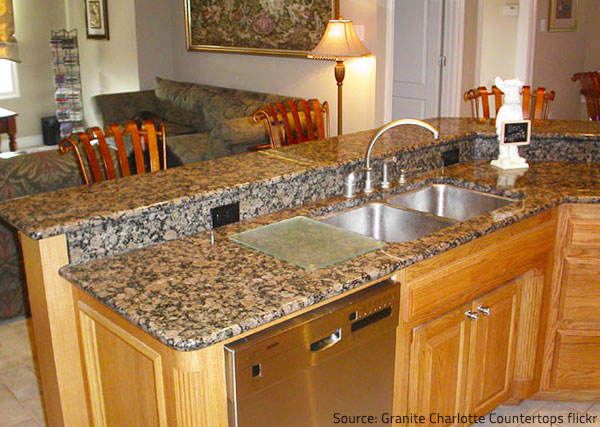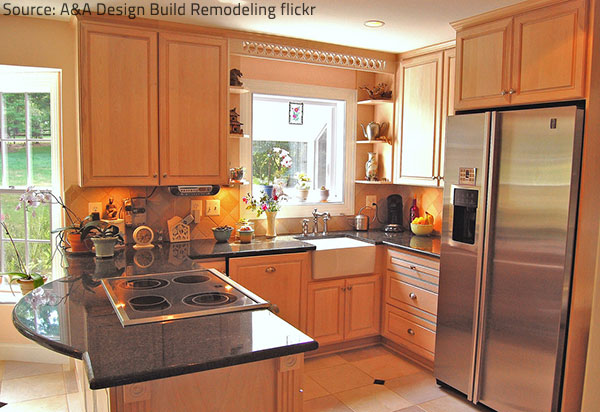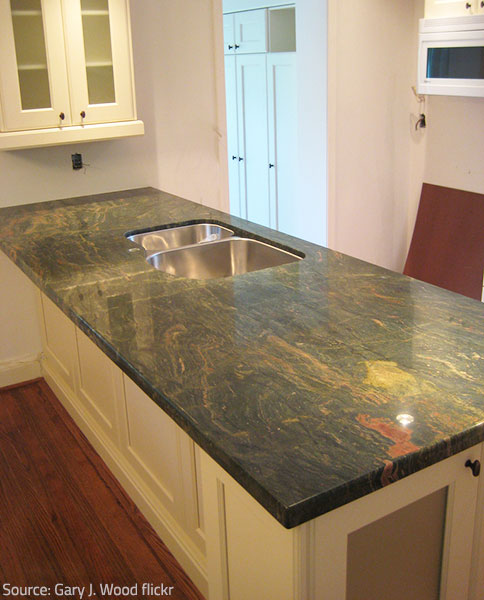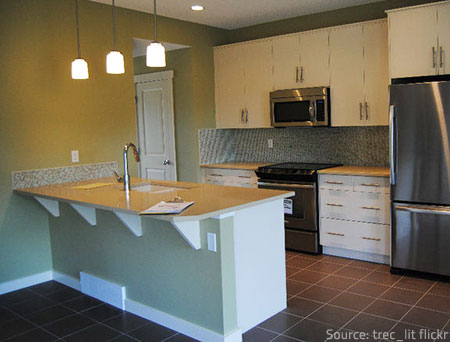Countertop Installation Recommendations
Countertop installation is one of the final stages of a new build or remodeling project – once the counters are put in place, your kitchen or bathroom will require just a few final touches before it is ready for use. To achieve the ultimate functionality and splendid look you’ve always wanted for your interior décor, you need to get the perfect countertops – in terms of materials, colors, design, installation, and ease of maintenanceMaintenance is the routine care, inspection, and repair of a... More:

It is the countertops that stand out in a room.
# Careful research and proper assessment of your practical needs and aesthetic preferences will help you choose the best countertop material and style for your home.
# Comparing the price estimates you receive from different retailers in your area and discussing the details of the installation process (extra conditions, specific requirements, time-frame of completion, etc.) with your potential partners will allow you to make an informed decision about your upcoming project and pick the contractor that best suits your needs, demands, and available budget.
# Good planning and adequate preparationPreparation is the steps taken to ready a property, equipmen... More will ensure a smooth and trouble-free installation process.
But what exactly do you need to do in order to achieve this? The expert countertop installation tips and recommendations below will help you prepare as well as possible and ensure the successful outcome of your project.
1) Countertop material and design
When looking for new countertops, you can choose from a great variety of materials and textures – from natural stones and quartz composites to acrylic sheets and butcher blocks. Each of them has its own distinctive look and specific advantages:
- Granite is very durable and comes in a wide array of rich colors and interesting patterns;
- Marble is exceptionally beautiful and has become symbolic of refinement and high style;
- Soapstone acquires beautiful patina with time and adds warmth and depth to the space;
- Quartz (engineered stone) is very strong and has easy-to-maintain, non-porous surfaceNon-porous surfaces are surfaces that do not absorb liquids ... More, ideal for food preparationPreparation is the steps taken to ready a property, equipmen... More;
- Wood (butcher block) offers warm, timeless appeal and brings coziness and natural charm to the interior décor;
- Concrete can be custom cast to create unique designs and suit your personal style;
- Laminate has a fashionable polished look and requires very little maintenanceMaintenance is the routine care, inspection, and repair of a... More;
- Stainless steel is extremely resilient and has remarkable reflective properties; etc.

Decide on the countertop material and style that best fits your practical needs and aesthetic preferences.
There is no right or wrong choice – juts make sure you pick the material that best suits your lifestyle and your aesthetic taste.
As far as your new countertop design is concerned, have in mind that the latest trends focus on sleekness and elegant simplicity – thin curvy countertops with rich texture, kitchen islands, and open floor plans have become the standard for contemporary homes.
2) Countertop support
Countertops are very heavy and need stable support. Most often, it is the kitchen cabinets (or bathroom vanities) that provide the necessary backing, so they need to be strong and sturdy enough to withstand the weight of the countertop:
- If you’re installing new cabinets, make sure you choose quality, robust pieces;
- If you intend to use your existing cabinetry, make sure that it is in excellent condition and will be able to support your chosen countertop – otherwise you’ll have to replace the old cabinets.
If you want (or need) a section of the countertop to overhang the cabinets, it’s a good idea to have additional brackets installed to support the protruding area.
Supporting the counter around your kitchen appliances will pose still further challenges – you may need to provide structural support on the side of the appliance or install wood blocking flush with the top of the adjacent cabinets.
3) Countertop installation considerations
Countertops are one of the final features to be installed in a new (or renewed) kitchen or bathroom. In order to make sure that all the elements in the room will work together well, you need to make a number of important decisions (type and position of sink, placement of faucets, type of backsplash, height of counter, location of overhangs, etc.) beforehand and have the cabinets in place and the hardware (sink, appliances, etc.) onsite on template date:
- The cabinetry must be installed prior to the final measurements and installation of the countertops;
- If you have decided on an apron or farmhouse sink, it must be installed prior to the template process;
- If you want a full-height backsplash, you need to have the upper cabinets (as well as any exhaust vents) installed prior to the final measurements;
- All appliances, such as refrigerators, ranges, dishwashers and microwaves, need to be in place prior to the installation process;
- If plumbing or electrical work is required (as is most often the case when installing new countertops), it needs to be scheduled for the day following the installation. (The sink, for example, will be put in place and the faucet holes will be drilled on installation day, but you won’t be able to use it before the plumber hooks up the faucet and drain.)

Proper countertop installation requires a lot of planning and careful preparations.
Good to know: The template process (site measurement) is very important as your chosen contractor needs to have a precise template to follow when building and installing your new countertops – you have to schedule a templating date when a certified fabricator can come to your home to take measurements and discuss the details of your project with you (backsplash requirements, position of sinks, cabinets, and seams, etc.) Make sure you don’t move anything between template date and installation!
4) Countertop installation time
Once the templating is done, you’ll have to wait about two weeks for the countertops to be fabricated. The actual installation process will be completed within several hours.
Good to remember: If you have existing countertops, they will have to be removed prior to the installation of the new ones, of course. This should be done at least 48 hours before the installation date, so that there is enough time to deal with eventual problems, make sure the cabinets are level, clean the site, etc. You can take care of this task yourself or have your chosen contractor remove and haul away the old counters for you (this extra service has to be requested at the time when you place your order and will incur an additional charge).
5) Countertop installation preparations
There are certain efficient measures you can take to speed up the installation process and prevent accidents and mishaps:
- Remove all items from your kitchen (or bathroom) cabinets. Take any fragile and/or valuable items (antiques, art pieces, lamps, vases, mirrors, wall hangings, etc.) away from the areas that will be affected by the installation work;
- Cover entryways and vents in the installation area with plastic sheeting to contain dust and debris. Cover furniture and floors along the path of the installers, as well as in the areas adjacent to the room where your new countertops will be installed, to prevent property damage;
- Create a clear path from the driveway to the installation area, so that the installation crew can maneuver the heavy countertops into and throughout your home safely and easily. Make sure the outdoor path is free from snow, ice, dead leaves, protruding branches or anything else that may create a tripping and/or falling hazard. The indoor path must be completely free of obstacles.

Take every possible measure to ensure the safety and efficiency of the countertop installation process.
6) Countertop installation process
During the actual installation work, keep in mind that:
- The installation process (as part of the construction process) will inevitably involve some hassle and inconveniences – noise, dust, restricted access to the room where the counters are being installed, etc. Make sure you plan accordingly to minimize disruption of your activities;
- Both the silicone and the epoxy used to seam materials together give off strong fumes, so the installation area needs to be well ventilated during and after the installation process;
- For the sake of safety, children and pets must be kept away from the areas that will be affected by the installation work;
- A person with authority to make decisions (an adult over the age of 18) has to be present during the installation process – certain details may have to be re-discussed or changed in the last minute (seam location, corner radius, etc.) and installation completion report must be signed when the work is over.
7) After the installation
- Inspect the work of your chosen contractor to confirm the damage-free condition of your new countertop and your satisfaction with the final results;
- Review the warranty;
- Ask for care and maintenanceMaintenance is the routine care, inspection, and repair of a... More instructions and advice;
- Complete the home improvement process – have the backsplashes installed, finish painting, etc.

When everything is ready, you will have the home decor of your dreams.
All things said and done, you’ll be able to achieve your dream home design and enjoy it for many years to come.












